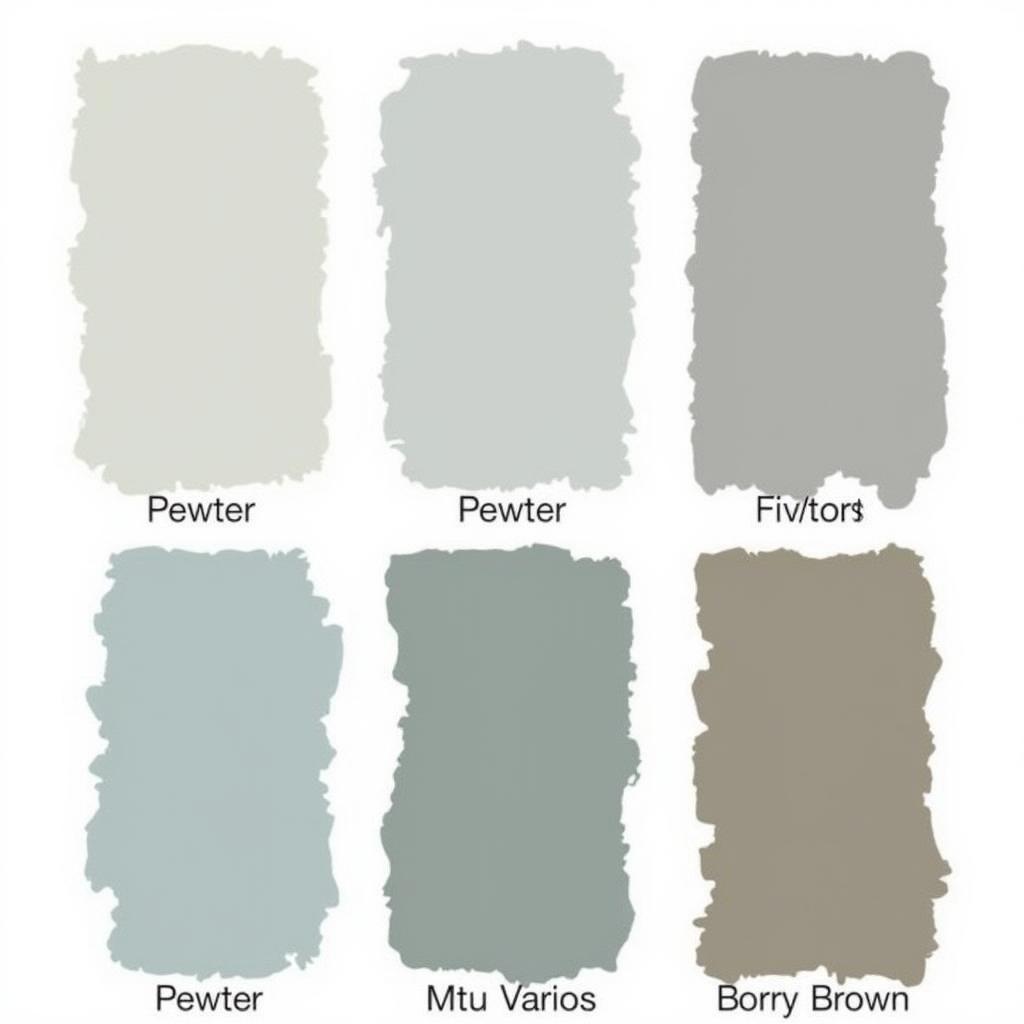Pewter, a color steeped in history and understated elegance, has become a staple in interior design. But what color pewter actually is can be surprisingly complex. This comprehensive guide delves into the nuances of pewter, exploring its various shades, complementary colors, and how to effectively incorporate this versatile hue into your living spaces.
Pewter’s allure lies in its adaptability. It’s not a single, definitive color, but rather a spectrum ranging from cool, silvery grays to warmer tones with hints of brown or green. This inherent complexity allows pewter to seamlessly integrate into diverse design styles, from traditional to contemporary and everything in between. Whether you’re aiming for a sophisticated, industrial aesthetic or a cozy, rustic vibe, pewter offers a foundation of timeless style. Understanding the subtle variations within the pewter family is key to unlocking its full potential in your home.
Decoding the Shades of Pewter
The beauty of pewter lies in its nuanced variations. While often described as a gray with metallic undertones, pewter can encompass a surprisingly diverse range of shades. Some popular variations include:
- Classic Pewter: This is the quintessential pewter, a balanced mid-tone gray with subtle blue or green undertones. It offers a sophisticated and versatile backdrop for various color palettes.
- Warm Pewter: Infused with hints of brown or beige, warm pewter creates a cozy and inviting atmosphere. It works particularly well in spaces with natural light.
- Cool Pewter: Leaning towards a silvery gray, cool pewter exudes a modern and sleek feel. It pairs beautifully with crisp whites and bold accent colors.
What Color is Revere Pewter? A Beloved Choice
One of the most sought-after pewter shades is Revere Pewter by Benjamin Moore. This popular choice is known for its chameleon-like ability to shift in appearance depending on the lighting and surrounding colors. It’s a complex greige, balancing gray and beige undertones, making it incredibly versatile and adaptable to various design styles. Revere Pewter is a go-to for creating a sophisticated and harmonious backdrop in any room.
What Colors Go with Revere Pewter? Creating Harmonious Palettes
what colors go with revere pewter
Revere Pewter’s neutral nature makes it a perfect companion for a wide array of colors. Here are some suggestions to inspire your color palette:
- Navy and White: This classic combination creates a timeless and sophisticated look with Revere Pewter as a grounding element.
- Greens and Blues: Earthy greens and calming blues complement the gray undertones of Revere Pewter, creating a serene and natural atmosphere.
- Warm Neutrals: Pairing Revere Pewter with other warm neutrals like beige, cream, and taupe creates a cozy and inviting space.
What Color Does Pewter Look Like? Visualizing the Hue
what color does pewter look like
Imagine the soft sheen of a well-worn antique metal. That’s the essence of pewter. It’s not a stark gray, nor a vibrant silver. Instead, it occupies a subtle middle ground, offering a quiet elegance that enhances rather than overpowers a space. Pewter’s inherent metallic undertones give it depth and dimension, allowing it to reflect light in a unique way.
 Pewter Paint Samples Comparison
Pewter Paint Samples Comparison
What Does the Color Pewter Look Like in Different Rooms?
what does the color pewter look like
Pewter’s versatility shines in various room settings:
- Living Rooms: Pewter walls create a sophisticated backdrop for gatherings, allowing furniture and décor to take center stage.
- Bedrooms: Pewter fosters a calming and restful ambiance, promoting relaxation and sleep.
- Kitchens: Pewter cabinets offer a timeless and elegant look, easily complementing various countertop materials and appliances.
“Pewter’s adaptability makes it a designer’s dream,” says renowned interior designer, Amelia Grant. “It’s a color that whispers rather than shouts, allowing other elements in the room to shine.”
“Don’t be afraid to experiment with different shades of pewter,” advises color consultant, David Miller. “The key is to find the perfect undertone that complements your existing décor and desired ambiance.”
In conclusion, pewter, with its subtle complexity and timeless appeal, offers a versatile color solution for any home. Whether you choose a classic, warm, or cool variation, understanding the nuances of this elegant hue is key to unlocking its full design potential. From creating a sophisticated backdrop to fostering a cozy atmosphere, pewter offers a timeless foundation for your interior design vision.
FAQ
- Is pewter a warm or cool color? Pewter can be both warm and cool, depending on its undertones.
- What is the difference between pewter and gray? Pewter typically has metallic undertones, while gray is a more flat, neutral color.
- What sheen is best for pewter paint? A satin or eggshell sheen is often recommended for pewter paint.
- What are some popular pewter paint colors besides Revere Pewter? Other popular options include Benjamin Moore’s Stonecraft and Sherwin-Williams’s Pewter Green.
- Can pewter be used in exterior paint? Yes, pewter can be a beautiful and sophisticated choice for exterior paint.
- What type of lighting works best with pewter? Both natural and artificial light can work well with pewter, but it’s important to consider the undertones and how they will be affected by the lighting.
- Can pewter be used in a small room? Yes, lighter shades of pewter can make a small room feel larger and brighter.
Further Exploration
- Explore more about the versatility of pewter in kitchen design.
- Discover how to create a calming bedroom sanctuary with pewter accents.
Need assistance with your color choices? Contact us at Phone: 0373298888, Email: [email protected] or visit us at 86 Cầu Giấy, Hanoi. Our 24/7 customer service team is ready to help.
